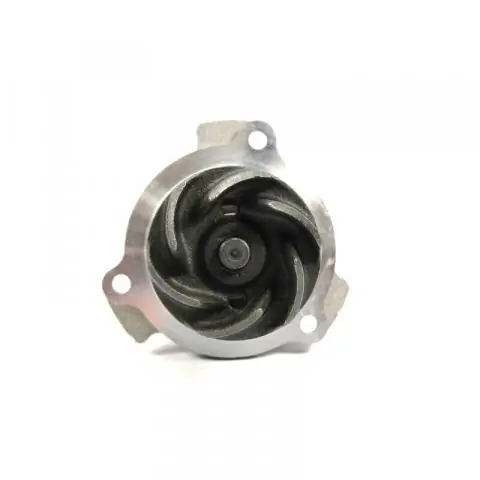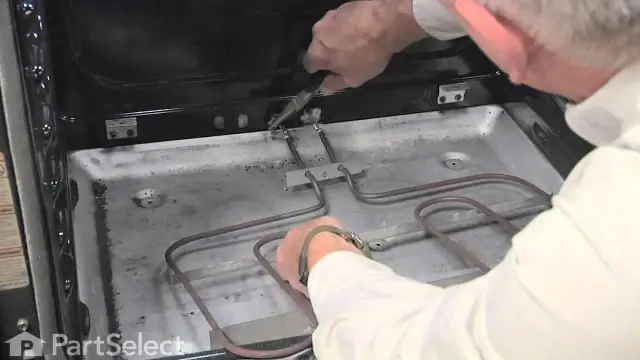
Table of contents:
- Author Bailey Albertson [email protected].
- Public 2023-12-17 12:53.
- Last modified 2025-01-23 12:41.
Purpose of the fan of the VAZ 2108/09 stove, malfunctions and their elimination

The stove in any car is designed to create a comfortable environment. However, this design has a vulnerable spot, which is the heater motor. If you have any problems with the fan, you can fix them yourself, and a visit to a car service becomes unnecessary.
Content
-
1 What is a stove fan
- 1.1 Purpose of the device
- 1.2 Where is the motor located on the VAZ 2108/09
- 1.3 Connection diagram
-
2 Heater fan VAZ 2108/2109
-
2.1 Reasons for failure
- 2.1.1 Fuse
- 2.1.2 Bad contact
- 2.1.3 Resistor
- 2.1.4 Switch
-
2.2 How to remove a stove motor on a VAZ 2108/09
2.2.1 Video: how to remove the heater motor
-
2.3 Disassembly and assembly of the fan
2.3.1 Video: disassembling the motor of the VAZ 2108/09 stove
-
What is a stove fan
A car heater, popularly called a stove, is designed to perform a simple and at the same time important function - heating the passenger compartment. In addition, the device helps to eliminate fogging of the glass in cold and damp weather. During normal operation of the heating system in the cabin of the "nine", a temperature of +20 ˚С should be maintained with the same indicators overboard, but only with a minus sign. In the legs, with the maximum heating mode, the value should be maintained at +25 ˚С. One of the important parts of the stove, in addition to the radiator, is the fan. The purpose of this device, its malfunctions and repairs should be considered in more detail.
Purpose of the device
The purpose of the motor is to increase the efficiency of the heating system and air circulation in the vehicle interior. Its work is based on the intake of air from the outside and its subsequent supply to the passenger compartment through the radiator. As a result of the passage of the air flow through the heat exchanger, the air enters the passenger compartment already warmed up.

Heater operation scheme: a - VAZ 2108; b - VAZ -2108-01: 1- fan impeller; 2 - air duct for heating the windshield; 3 - windshield heating flap; 4 - driver's feet heating flap; 5 - flap of the central nozzle; 6 - central nozzle; 7- radiator; 8 - heater control damper; 9 - window for heating the driver's feet; 10 - internal ventilation duct
Where is the motor located on the VAZ 2108/09
The stove motor on the VAZ 2108/09 is installed in a niche in the engine compartment in front of the windshield, which is fundamentally different from the design of the heater in classic Zhiguli, in which the fan is installed in the cabin. The unit is an electric motor with an impeller mounted on it, through which air is pumped into the passenger compartment.

The stove motor on the VAZ 2108/09 is installed in a niche in the engine compartment in front of the windshield
Connection diagram
To facilitate the search for possible malfunctions with a fan, an installation diagram may sometimes be required, the main components of which are:
- mounting block of fuses;
- egnition lock;
- additional resistor;
- fan motor;
- mode switch.

The stove motor connection diagram consists of a fuse mounting block, an ignition switch, an additional resistor, a fan motor, an operation mode switch
Heater fan VAZ 2108/2109
Damage to the stove motor, although not so often, still occurs. If this unit fails, the quality of heating is significantly reduced. Depending on the nature of the problem, there may be background noise that distracts the driver's attention. In this situation, repair or replacement of the device is required, for which it must be dismantled from the car.
Reasons for failure
There are a few of the most common causes of fan problems.
Fuse
One of the probable reasons leading to a malfunction of the motor may be a fuse malfunction. The element is located in a mounting block installed in the engine compartment in front of the windshield on the left side. Checking this part is the starting point for troubleshooting. The fuse is marked F7 and rated 30 A.

The fuse for the stove is located in the mounting block under the F7 marking and has a rating of 30 A
Bad contact
The contacts can oxidize over time. The check is not difficult to carry out, for this it is enough to move the block with the harnesses. If the fan starts working during the diagnostics, then the reason is found. You can eliminate the malfunction by stripping the problem contact in the mounting block.
Resistor
The functioning of the electric motor may be impaired due to malfunctions of the additional resistor. At maximum speed, the motor is connected directly to the power circuit, and at the first two speeds through a resistor. If there are problems with this particular element, then the electric motor will only work in maximum mode. To replace the part located on the left side of the stove body, just unscrew the fasteners and install a new resistor.

If the stove resistor fails, the heater will operate only at maximum speed
Switch
Sometimes there may be problems with the heater mode switch itself. The most likely cause is oxidized contacts (inside or outside) or the back of the part that has come off vibrations.

The contacts of the stove switch may oxidize or the back part may move away
In addition to the above reasons, damage to the electric motor itself is possible, for example, wear of the brushes. There may be various problems with the same anchor:
- pollution;
- wear;
- short circuit of the windings.
How to remove a stove motor on a VAZ 2108/09
To dismantle the assembly, you will need to prepare the following tools:
- Phillips screwdriver
- head 10;
- ratchet handle.

To remove the stove motor, you need a 10 head, a Phillips screwdriver and a ratchet
Then you can start removing the device:
-
Raise the hood, unscrew the screws securing the plastic cover near the windshield and remove it to the side.

Lining fasteners To remove the plastic cover, you will need to unscrew the corresponding fasteners
-
Remove the bonnet seal.

Bonnet seal The bonnet seal is removed with a simple hand movement
-
We dismantle the protective cover, behind which the motor itself is installed.

Protective cover To get close to the heater motor, you will need to remove the protective cover
-
We unscrew the bolts securing the fan to the body.

Fan mount The fan is fixed to the body with screws
-
We move to the salon, find a “+” wire from the electric motor under the dashboard on the driver's side and disconnect it. To remove the negative contact with a ratchet and a head for 10, unscrew the nut.

Motor connector To disconnect the fan electrical circuit, you need to move to the passenger compartment under the dashboard
-
We take out the motor, for which we rotate it, choosing the optimal position for extraction.

Heater motor To remove the electric motor, it must be turned in different directions.
Video: how to remove the heater motor
Disassembly and assembly of the fan
After dismantling the motor, it is subjected to troubleshooting, for which the unit will need to be disassembled. We carry out the work in the following order:
-
We separate the foam rubber seal from the casing of the electric motor.

Motor seal Dismantling the fan begins by removing the seal from the case
- Dismantle the support from the motor housing.
-
Prying the latch of the motor cover with a screwdriver, disengage them, and then disconnect the parts of the case.

Cover latches The casing latches are removed with a screwdriver
-
Remove the two latches with a screwdriver.

Cover latches The fan cover is secured with two metal clips
-
Dismantle the fan cover.

Fan cover After removing the latches, dismantle the cover
-
We take out the motor together with the impeller.

Motor and impeller We remove the motor along with the impeller
-
We unscrew the two screws securing the brush holder.

Fastening the brush holder The brush holder is attached with screws - unscrew them
-
We remove two cage nuts.

Cage nuts Removing the cage nuts with a screwdriver
-
We examine the collector (anchor). When burning, the presence of scratches and scratches, we clean the working surface with fine sandpaper.

Motor anchor Examine the anchor for damage
-
We take out the springs from the guide brushes. We inspect the brushes for wear and, if necessary, replace them.

Brush spring We inspect the brushes and, if necessary, replace them
-
Insert the cage nuts.

Installation of fasteners Install the nuts, holding them with pliers
-
We put an insulating washer on the armature shaft.

Insulating washer We put an insulating washer on the armature shaft
-
Bend the edges of the guides carefully.

Bending the guides To install the brushes, bend the guide
-
We insert the brushes all the way into the guides.

Installation of brushes The brushes are inserted all the way
-
We mount the brush holder on the motor.

Brush holder Installing the brush holder on the fan
-
Place the brush springs in the guides.

Installation of springs Install the springs of the brushes in the guides
-
Bend the edges of the guides.

Folding the guides To prevent the springs from falling out, bend the edges of the guides
-
We put spring clips on the cage nuts.

Clamp installation We put spring clips on the cage nuts
-
We insert the electric motor into the left side of the fan housing.

Installing an electric motor After assembling the motor, insert it into the left side of the case
-
We install the motor cover and fix it with spring clips.

Cover installation The motor cover is installed and secured with clips
- We dock and snap in the two parts of the case, and then put on the plastic support.
Video: disassembly of the VAZ 2108/09 stove motor
Otherwise, the assembly is carried out in the reverse order.
If there is no time or desire to repair, the unit is simply changed to a new one. As for the choice of a new part, then, as an option, preference can be given to the Luzar electric fan.

One of the worthy fan options is a product from Luzar.
Regardless of whether you own a VAZ 2108 or a VAZ 2109, the process of dismantling and replacing the stove motor on these cars is lonely and does not take much time. Having prepared the necessary tools and following step-by-step instructions, almost everyone who has decided to repair the heating system on their own can complete the procedure.
Recommended:
What To Do If, After Flashing Android, The Phone Or Tablet Does Not Turn On, Does Not See The Network, Does Not Charge

Why does my smartphone or tablet not work after changing the Android version. How to troubleshoot various problems. How to properly reflash a device
Replacing The Fan Of The Kalina Stove: How To Change If It Does Not Work, Do It Yourself Repair

The main functions of the heating fan and its location. Reasons for replacing the fan and signs of failure. Fan and resistor replacement process
Why On Windows 10 The Start Button Does Not Work And The Main Menu Does Not Open

The most common problems in the "Start" menu on Windows 10. The reasons for the appearance. Solutions: universal and for specific cases
What To Do If Google Chrome Does Not Work - Reasons And Solutions For Problems With The Browser, Including When It Does Not Start

The reasons why Google Chrome does not work: does not start, pages do not open, a gray screen is displayed, and so on. Solutions with photos and videos
What To Do If Yandex Browser Does Not Open On A Computer - Why The Program Does Not Start, How To Make It Work

Why "Yandex Browser" does not open in Windows. Solution to the problem: disabling autorun, updating and reinstalling the browser, clearing the cache and registry
